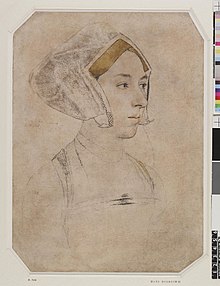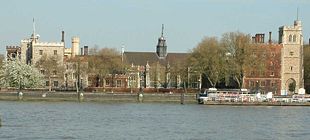Matthew Parker
Along with the pioneering scholar Lawrence Nowell, Parker's work concerning Old English literature laid the foundation for Anglo-Saxon studies.[11][2] At Cambridge he was able to read the works of Martin Luther,[9] and had access to books by married theologians from the Continent[12] — he first commended clerical marriage when he was a student there.Brook commented that for Parker "his new post provided him with a happy and quiet place of retirement in the country to which he became devoted"; and allowed him to pursue his enthusiasm for education and the sponsorship of new buildings.[24] His successful revitalisation of the college caused its reputation to spread, and he was able to protect it from being dissolved by citing the good work being done there; it retained its status until after Henry's death in 1547.[2][15] In 1539 he was denounced to the Lord Chancellor, Thomas Audley, by his opponents at Stoke-by-Clare,[26] who accused him of heresy and using "disloyal language against Easter, relics and other details".[29] Upon his election he began the process of putting organising its finances properly, which enabled him to repair the buildings and construct new ones' the master's Lodgings, the college halls and many of the students' rooms were improved.During his year in office he got into some trouble with the Chancellor of Cambridge University, Stephen Gardiner, over a play, Pammachius, performed by the students and censored by the college, which derided the old ecclesiastical system.He took advantage of the new reign to marry in June 1547, before clerical marriages were legalised by Parliament and Convocation, Margaret, daughter of Robert Harlestone, a Norfolk squire.During Kett's Rebellion, he preached at the rebels' camp on Mousehold Hill near Norwich, without much effect, and later encouraged his secretary, Alexander Neville, to write his history of the rising.As a supporter of Northumberland and a married man, under the new regime, Parker was deprived of his deanery, his mastership of Corpus Christi and his other preferments.The historian James D. Wenn has suggested that Parker may have enjoyed the protection of Sir Rowland Hill of Soulton, Shropshire, during this time.He was not eager to assume this task, and made great efforts to avoid promotion to Archbishop of Canterbury, which Elizabeth designed for him as soon as she had succeeded to the throne.Elizabeth wanted a moderate man, so she chose Parker on the recommendations of William Cecil, 1st Baron Burghley, her chief adviser.Elizabeth had a strong prejudice against married clergy, and in addition, she seems to have disliked Margaret Parker personally, often treating her so rudely that her husband was "in horror to hear it".In 1562 Parker granted a special licence to Thomas Ashton to become the founding headmaster of Shrewsbury School, which his associate Sir Rowland Hill had helped to on the grounds that that Ashton not being available would damage the progress of the school's foundation, potential significance attaches to this because of the innovative approaches to teaching and drama that institution went on to exhibit.He was convinced that if ever Protestantism was to be firmly established in England at all, some definite ecclesiastical forms and methods must be sanctioned to secure the triumph of order over anarchy, and he vigorously set about the repression of what he thought a mutinous individualism incompatible with a catholic spirit."[39] Parker's consecration gave rise to a dispute, which continues to this day, in regard to its sacramental validity from the perspective of the Roman Catholic Church.Rather the Pope asserted in the condemnation that the "defect of form and intent" rendered the rite insufficient to make a bishop in the apostolic succession (according to the Roman Catholic understanding of the minima for validity).[43] They also pointed out that none of the priests ordained with the English Ordinal were re-ordained as a requirement by Queen Mary - some did so voluntarily and some were re-anointed, a practice common at the time.[44] On the contrary, the Queen, unhappy about married clergy, ordered all of them, estimated at 15% of the total at the beginning of her reign in 1553, to put their wives away.The Commons approved the changes and the Lords 21-18 approved after pressure was brought to bear on them; concessions were made in a more Catholic tone in eucharistic doctrine, and allowance made for the use of Mass vestments and other traditional clerical dress in use in the second year of the reign of Edward VI, i.e. January 1548 to 49, when the Latin Rite was still the legal form of worship (the 'Ornaments Rubric' in the 1559 Prayer Book seems to refer to the allowance as set forth in the 1549 BCP).Two of the four, William Barlow and John Hodgkins had in Rome's view valid orders, since, having been made bishops in 1536 and 1537 with the Roman Pontifical in the Latin Rite, their consecrations met the criteria according to the definition stated in Apostolicae Curae.Early presbyterians wanted no bishops, and the conservatives opposed all these changes, often preferring to move in the opposite direction toward the practices of the Henrician church.






Matthew Parker (disambiguation)John Parker (bishop)The Most ReverendArchbishop of CanterburyChurch of EnglandReginald PoleEdmund GrindalWilliam BarlowNorwichLambethJohn HodgkinsJohn ScoryMyles CoverdaleLambeth PalacebishoptheologianThomas CranmerRichard HookerAnglicanThirty-nine ArticlesmanuscriptsSt Augustine GospelsAnglo-Saxon ChronicleLawrence NowellOld English literatureAnglo-Saxonworstedweaverarchbishops of CanterburyJohn StrypeCambridge UniversityCorpus Christi CollegeMartin Lutherclerical marriageThomas BilneyBachelor of ArtsGeorg BraunFrans HogenbergCambridgedeaconfellowheresyrecantedburnt at the stakeCardinalThomas WolseyCardinal CollegeOxfordMaster of ArtsHans Holbein the YoungerBritish MuseumAnne Boleynchaplainsecular canonsStoke-by-ClareSuffolksecularisedoffices of the churchchoirboysBishop of NorwichCatherineElizabethBachelor of DivinityDoctor of DivinityLord ChancellorThomas AudleyprebendCorpus Christi College, CambridgeStephen GardinerAct of ParliamentchantriesNorfolkKett's RebellionMousehold HillAlexander NevilleProtestantismJohn Dudley, 1st Duke of NorthumberlandEdward Seymour, 1st Duke of SomersetProtestantMartin BucerLincolnMary TudorSir Rowland HillSoultonGeneva BibleWilliam Cecil, 1st Baron BurghleyadulteryincestcelibacyconsecrateBishop of Bath and WellsBishop of ChichesterMiles CoverdaleBishop of ExeterBishop of Bedfordallegation of an indecent consecration at the Nag's Head public houseChristopher HolywoodRoyal SupremacyHouse of CommonsHouse of LordsEdwardine OrdinalThomas AshtonShrewsbury SchoolThomas TallisNine Tunes for Archbishop Parker's PsalterParker SocietyMary Queen of Scotspapal commissionliturgicalEastern-riteChurch of IrelandPrivy CouncilevangelicalvestmentspresbyteriansimprimaturPuritanconvocationBook of AdvertisementsJohn FoxePeter WentworthWestminster AbbeyRiver ThamesThe Old PalaceCanterbury CathedralMatthew Paris